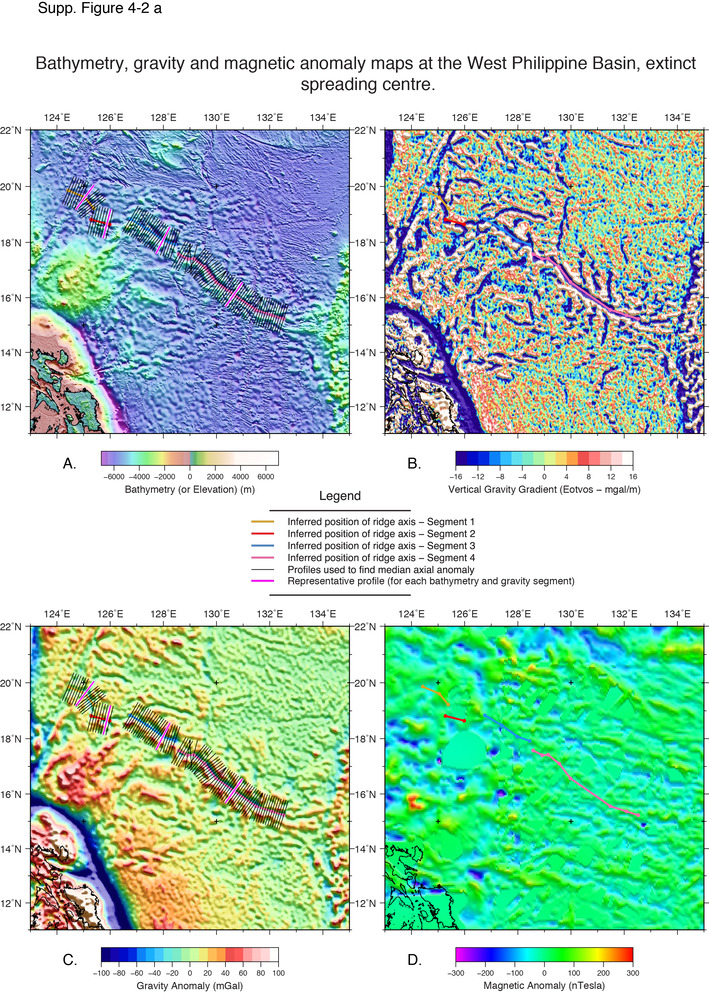| Ocean: | Marginal basin |
| Spreading center type: | Back-arc or intra-oceanic spreading center |
| Time of cessation: | Ca. 36 Ma, after C18n2n (Sasaki et al., 2014); also proposed ca. 37 Ma (Mrozowski et al., 1982); 25 Ma (Shih, 1980); 40 Ma (Hilde and Lee, 1984). |
| Subsequent active spreading center: | None in immediate area |
| Cessation style: | Reported to have been abrupt |
| Later deformation or volcanism: | Mrozowski et al. (1982) propose that post-spreading faulting has disrupted the structure of the spreading axis. |
The location of the extinct spreading center within the West-Philippine Basin is relatively well-constrained by a prominent axial anomaly yet, some uncertainty remains regarding the age of the oceanic crust within this basin. The extinct ridge axis trends roughly east-west and has a clear trough morphology, extending for over around 1000km. The West Philippine Basin extinct ridge was included in a previous study of four extinct spreading centers by Jonas et al. (1991), who sought to explain the presence of low-gravity anomalies that were observed at profiles across these centres.
The West-Philippine Basin ridge was first identified by Ben-Avraham et al. (1972), who noted its similarity to an active mid-ocean ridge. Ben-Avraham et al. (1972) suggested that the ocean crust within the basin had formed at a segment of the Kula-Pacific spreading center that failed to be subducted due to a change in the direction of the Pacific Plate, related to plate fragmentation. Early studies proposed that spreading ceased at around 60 Ma (Ben Avraham et al., 1972; Uyeda and Miyashiro, 1974), although some studies also proposed a Cretaceous age for the ocean crust as summarized in Shih (1980).
Sasaki et al. (2014) summarize the key models proposed for the evolution of the West Philippine Basin and Palau Basin since that time and the continued controversy regarding interpretation of the magnetic anomalies within the basins. Sasaki et al. (2014) outline the three alternative interpretations, which that had been proposed that vary by up to 15 Myrs with respect to the proposed time of ridge extinction (Mrozowksi et al., 1982; Shih, 1980; Hilde and Lee, 1984). An updated interpretation was presented from updated marine track data using three-component magnetic measurements for the southern flank of the West Philippine Basin and for the east of the Palau Basin (Sasaki et al., 2014). This updated model primarily questions the age and the spreading history of the Palau Basin and crust to the south of 10 N, that may have been formed from an east-west oriented spreading system (Sasaki et al., 2014).
Okino and Fujioka (2003) provide the most detailed study of the extinct ridge axis and observe that the segments of the spreading axis have extremely variable morphology, suggesting differential spreading rates along-axis. The post-spreading deformation suggested by Mrozowski et al (1982) is supported by later detailed mapping studies (Deschamps et al., 2002; Okino and Fujioka, 2003).
Uyeda and Miyashiro (1974) hypothesized that the West Philippine basin ridge became extinct due to change in direction of the Pacific plate, which stalled the active subduction of the segment of Kula-Pacific plate boundary. Cessation of spreading is proposed to be also linked to the initiation of a subduction zone to the east of the West Philippine extinct ridge, which explains the volcanic arcs that are found in the central and eastern portion of the basin (Uyeda and Miyashiro, 1974).
Shih (1980) argues that the West Philippine Basin spreading center may have been part of a continuous plate boundary on the southwest border of the Pacific Plate, that may have been disrupted by a change in the direction of plate motion due to the proposed development of an active subduction zone at the Palau-Kyushu Ridge. It is proposed that the basin then became isolated from the Pacific, but that it continued spreading whilst the plate was rotated until around 26 Ma (Shih, 1980).
Ben-Avraham, Z., Bowin, C. and Segawa, J. 1972, An extinct spreading centre in the Philippine Sea. Nature, v. 240, p. 453-455.
Deschamps, A., Okino, K. and Fujioka, K., 2002, Late amagmatic extension along the central and eastern segments of the West Philippine Basin fossil spreading axis, Earth and Planetary Science Letters, v. 203, p. 277-293.
Hilde, T. W. C. and Lee, Chao-Shing, 1984, Origin and evolution of the West Philippine Basin: A new interpretation, Tectonophysics, v. 102, p. 85- 104.
Jonas, J., Hall, S. and Casey, J. F., 1991, Gravity anomalies over extinct spreading centers: A test of gravity models of active centers, Journal of Geophysical Research, v. 96, no. B7, p. 11,759-11,777.
Mrozowski, C. L., Lewis, S. D. and Hayes, D. E., 1982, Complexities in the tectonic evolution of the West Philippine Basin, Tectonophysics, v. 82, p. 1-24.
Okino, K. and Fujioka, K., 2003, The Central Basin spreading centre in the Philippine Sea: Structure of an extinct spreading centre and implications for marginal basin formation, Journal of Geophysical Research, v. 108, no. B1, doi: 10.1029/2001JB001095.
Sasaki, T., Yamazaki, T. and Ishizuka, O., 2014, A revised spreading model of the West Philippine Basin, Earth, Planets and Space, 66:83, doi:10.1186/1880-5981-66-83.
Shih, Tai-chang, 1980, Marine magnetic anomalies from the Western Philippine Basin: Implications for the evolution of marginal basins, In, Hayes, D.E., ed, The Tectonic and Geological evolution of Southeast Asian Seas and Islands, Geophysical Monograph Series, v. 23, Americal Geophysical Union, p. 49-75.
Uyeda, S. and Miyashiro, A. 1974, Plate tectonics and the Japanese Islands: A synthesis, Geological Society of America Bulletin, v. 85, p. 1159-1170.


